Impact of Tariffs on Industries and Economy: Trade Enterprise
VerifiedAdded on 2023/03/21
|9
|3885
|80
Report
AI Summary
This report provides a comprehensive analysis of the effects of tariffs on industries and the economy. It begins by explaining how tariffs protect infant industries from competition by increasing import duties, thereby promoting local production. The report then discusses the broader economic impacts of tariffs, including their effects on market prices, trade volumes, and various sectors of the economy. It also examines the potential benefits of tariffs, such as reducing consumption of specific goods, expanding the economy, generating government revenue, protecting local industries, creating employment, and preventing dumping. The report references examples such as the United States' tariffs on steel and aluminum and the potential effects of tariffs on the UK economy, highlighting both the protective and potentially detrimental effects of tariffs on economic welfare.
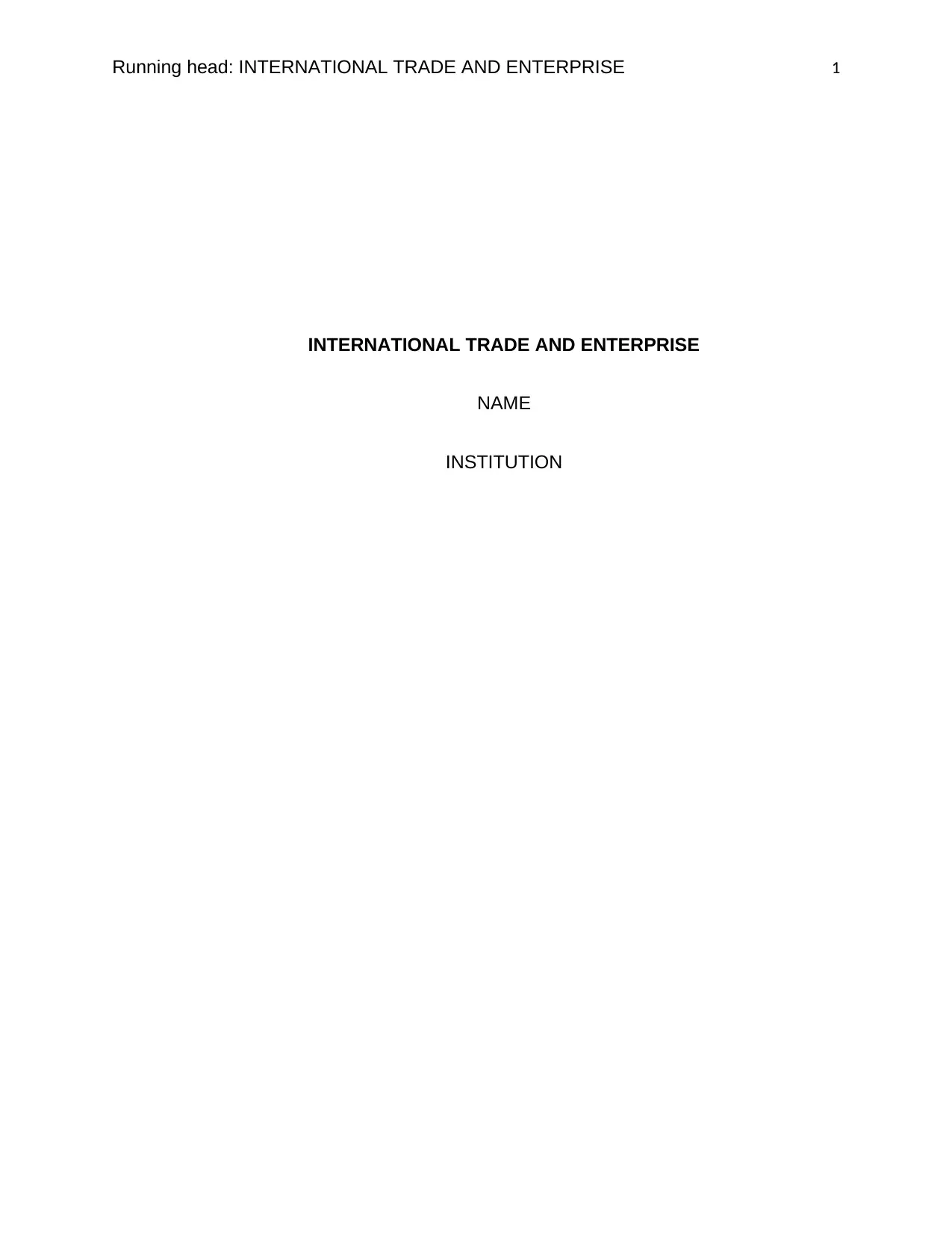
Running head: INTERNATIONAL TRADE AND ENTERPRISE 1
INTERNATIONAL TRADE AND ENTERPRISE
NAME
INSTITUTION
INTERNATIONAL TRADE AND ENTERPRISE
NAME
INSTITUTION
Paraphrase This Document
Need a fresh take? Get an instant paraphrase of this document with our AI Paraphraser
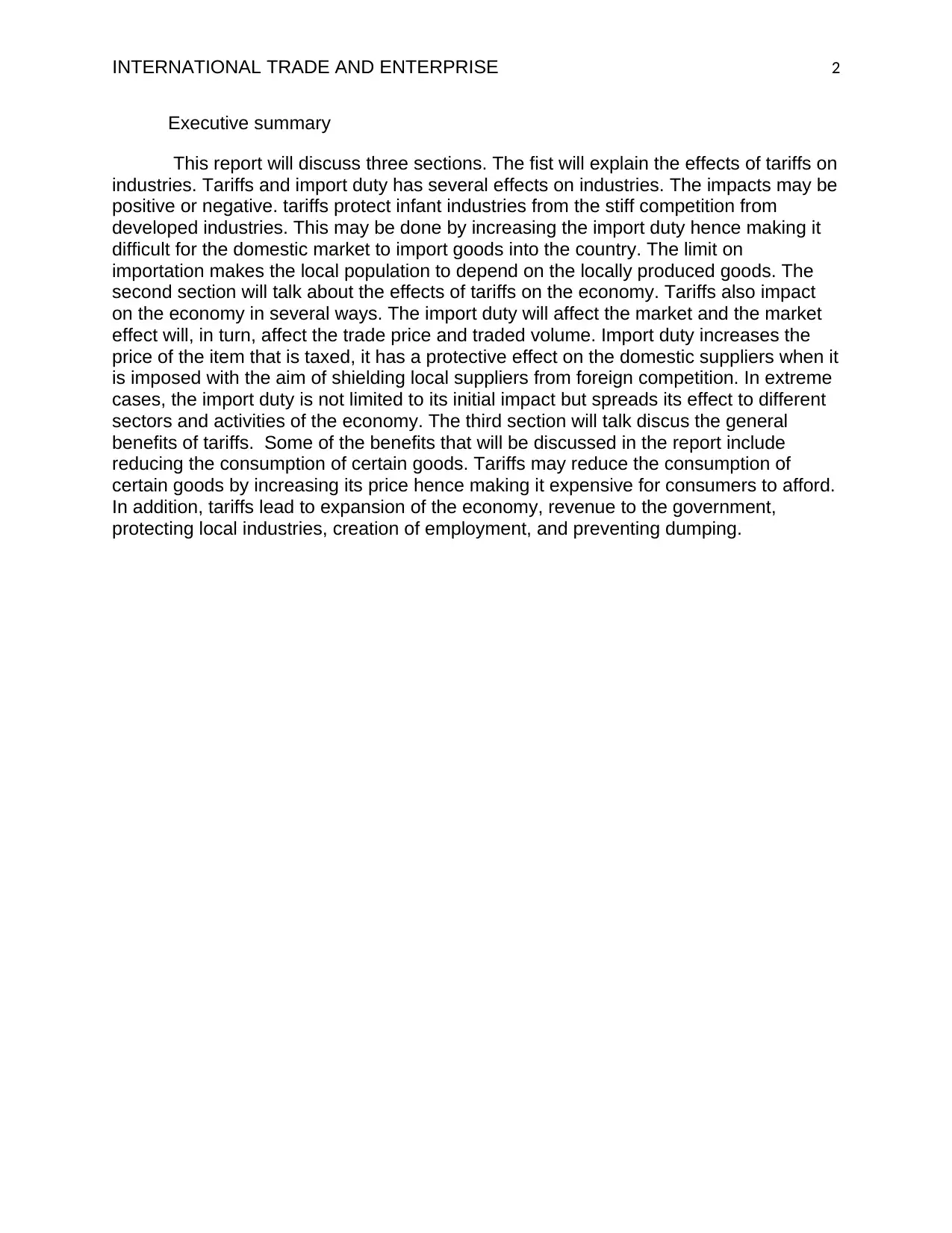
INTERNATIONAL TRADE AND ENTERPRISE 2
Executive summary
This report will discuss three sections. The fist will explain the effects of tariffs on
industries. Tariffs and import duty has several effects on industries. The impacts may be
positive or negative. tariffs protect infant industries from the stiff competition from
developed industries. This may be done by increasing the import duty hence making it
difficult for the domestic market to import goods into the country. The limit on
importation makes the local population to depend on the locally produced goods. The
second section will talk about the effects of tariffs on the economy. Tariffs also impact
on the economy in several ways. The import duty will affect the market and the market
effect will, in turn, affect the trade price and traded volume. Import duty increases the
price of the item that is taxed, it has a protective effect on the domestic suppliers when it
is imposed with the aim of shielding local suppliers from foreign competition. In extreme
cases, the import duty is not limited to its initial impact but spreads its effect to different
sectors and activities of the economy. The third section will talk discus the general
benefits of tariffs. Some of the benefits that will be discussed in the report include
reducing the consumption of certain goods. Tariffs may reduce the consumption of
certain goods by increasing its price hence making it expensive for consumers to afford.
In addition, tariffs lead to expansion of the economy, revenue to the government,
protecting local industries, creation of employment, and preventing dumping.
Executive summary
This report will discuss three sections. The fist will explain the effects of tariffs on
industries. Tariffs and import duty has several effects on industries. The impacts may be
positive or negative. tariffs protect infant industries from the stiff competition from
developed industries. This may be done by increasing the import duty hence making it
difficult for the domestic market to import goods into the country. The limit on
importation makes the local population to depend on the locally produced goods. The
second section will talk about the effects of tariffs on the economy. Tariffs also impact
on the economy in several ways. The import duty will affect the market and the market
effect will, in turn, affect the trade price and traded volume. Import duty increases the
price of the item that is taxed, it has a protective effect on the domestic suppliers when it
is imposed with the aim of shielding local suppliers from foreign competition. In extreme
cases, the import duty is not limited to its initial impact but spreads its effect to different
sectors and activities of the economy. The third section will talk discus the general
benefits of tariffs. Some of the benefits that will be discussed in the report include
reducing the consumption of certain goods. Tariffs may reduce the consumption of
certain goods by increasing its price hence making it expensive for consumers to afford.
In addition, tariffs lead to expansion of the economy, revenue to the government,
protecting local industries, creation of employment, and preventing dumping.
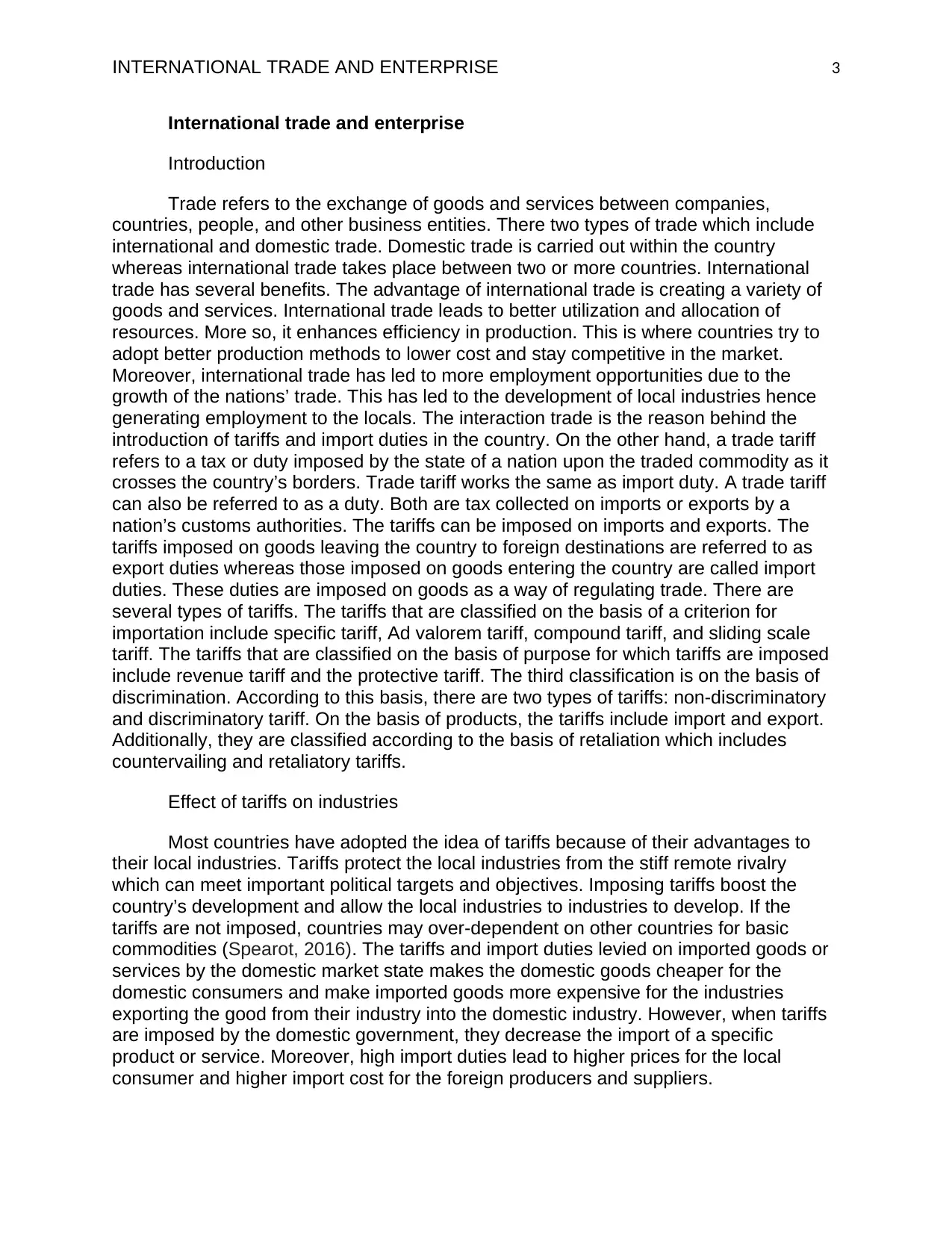
INTERNATIONAL TRADE AND ENTERPRISE 3
International trade and enterprise
Introduction
Trade refers to the exchange of goods and services between companies,
countries, people, and other business entities. There two types of trade which include
international and domestic trade. Domestic trade is carried out within the country
whereas international trade takes place between two or more countries. International
trade has several benefits. The advantage of international trade is creating a variety of
goods and services. International trade leads to better utilization and allocation of
resources. More so, it enhances efficiency in production. This is where countries try to
adopt better production methods to lower cost and stay competitive in the market.
Moreover, international trade has led to more employment opportunities due to the
growth of the nations’ trade. This has led to the development of local industries hence
generating employment to the locals. The interaction trade is the reason behind the
introduction of tariffs and import duties in the country. On the other hand, a trade tariff
refers to a tax or duty imposed by the state of a nation upon the traded commodity as it
crosses the country’s borders. Trade tariff works the same as import duty. A trade tariff
can also be referred to as a duty. Both are tax collected on imports or exports by a
nation’s customs authorities. The tariffs can be imposed on imports and exports. The
tariffs imposed on goods leaving the country to foreign destinations are referred to as
export duties whereas those imposed on goods entering the country are called import
duties. These duties are imposed on goods as a way of regulating trade. There are
several types of tariffs. The tariffs that are classified on the basis of a criterion for
importation include specific tariff, Ad valorem tariff, compound tariff, and sliding scale
tariff. The tariffs that are classified on the basis of purpose for which tariffs are imposed
include revenue tariff and the protective tariff. The third classification is on the basis of
discrimination. According to this basis, there are two types of tariffs: non-discriminatory
and discriminatory tariff. On the basis of products, the tariffs include import and export.
Additionally, they are classified according to the basis of retaliation which includes
countervailing and retaliatory tariffs.
Effect of tariffs on industries
Most countries have adopted the idea of tariffs because of their advantages to
their local industries. Tariffs protect the local industries from the stiff remote rivalry
which can meet important political targets and objectives. Imposing tariffs boost the
country’s development and allow the local industries to industries to develop. If the
tariffs are not imposed, countries may over-dependent on other countries for basic
commodities (Spearot, 2016). The tariffs and import duties levied on imported goods or
services by the domestic market state makes the domestic goods cheaper for the
domestic consumers and make imported goods more expensive for the industries
exporting the good from their industry into the domestic industry. However, when tariffs
are imposed by the domestic government, they decrease the import of a specific
product or service. Moreover, high import duties lead to higher prices for the local
consumer and higher import cost for the foreign producers and suppliers.
International trade and enterprise
Introduction
Trade refers to the exchange of goods and services between companies,
countries, people, and other business entities. There two types of trade which include
international and domestic trade. Domestic trade is carried out within the country
whereas international trade takes place between two or more countries. International
trade has several benefits. The advantage of international trade is creating a variety of
goods and services. International trade leads to better utilization and allocation of
resources. More so, it enhances efficiency in production. This is where countries try to
adopt better production methods to lower cost and stay competitive in the market.
Moreover, international trade has led to more employment opportunities due to the
growth of the nations’ trade. This has led to the development of local industries hence
generating employment to the locals. The interaction trade is the reason behind the
introduction of tariffs and import duties in the country. On the other hand, a trade tariff
refers to a tax or duty imposed by the state of a nation upon the traded commodity as it
crosses the country’s borders. Trade tariff works the same as import duty. A trade tariff
can also be referred to as a duty. Both are tax collected on imports or exports by a
nation’s customs authorities. The tariffs can be imposed on imports and exports. The
tariffs imposed on goods leaving the country to foreign destinations are referred to as
export duties whereas those imposed on goods entering the country are called import
duties. These duties are imposed on goods as a way of regulating trade. There are
several types of tariffs. The tariffs that are classified on the basis of a criterion for
importation include specific tariff, Ad valorem tariff, compound tariff, and sliding scale
tariff. The tariffs that are classified on the basis of purpose for which tariffs are imposed
include revenue tariff and the protective tariff. The third classification is on the basis of
discrimination. According to this basis, there are two types of tariffs: non-discriminatory
and discriminatory tariff. On the basis of products, the tariffs include import and export.
Additionally, they are classified according to the basis of retaliation which includes
countervailing and retaliatory tariffs.
Effect of tariffs on industries
Most countries have adopted the idea of tariffs because of their advantages to
their local industries. Tariffs protect the local industries from the stiff remote rivalry
which can meet important political targets and objectives. Imposing tariffs boost the
country’s development and allow the local industries to industries to develop. If the
tariffs are not imposed, countries may over-dependent on other countries for basic
commodities (Spearot, 2016). The tariffs and import duties levied on imported goods or
services by the domestic market state makes the domestic goods cheaper for the
domestic consumers and make imported goods more expensive for the industries
exporting the good from their industry into the domestic industry. However, when tariffs
are imposed by the domestic government, they decrease the import of a specific
product or service. Moreover, high import duties lead to higher prices for the local
consumer and higher import cost for the foreign producers and suppliers.
⊘ This is a preview!⊘
Do you want full access?
Subscribe today to unlock all pages.

Trusted by 1+ million students worldwide
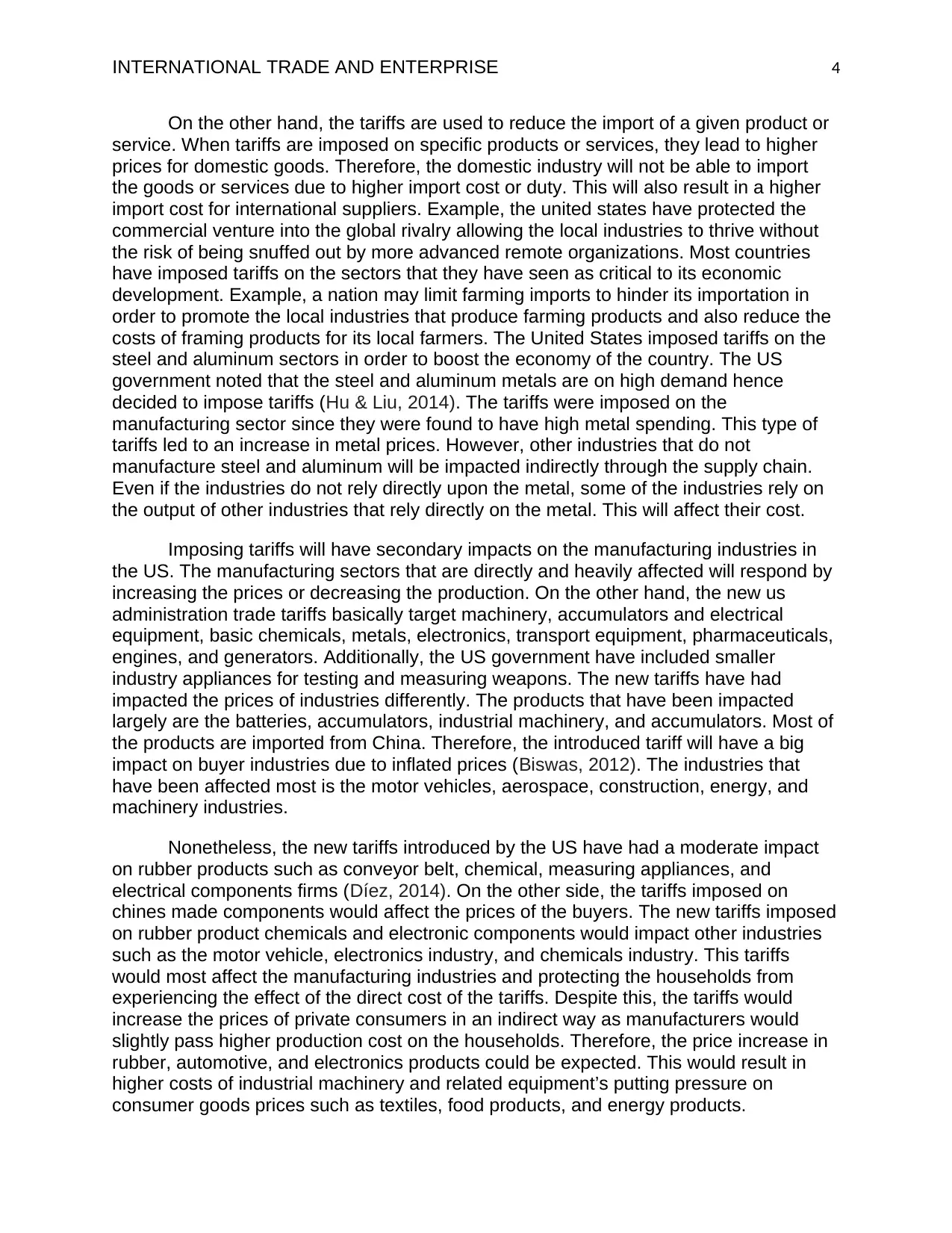
INTERNATIONAL TRADE AND ENTERPRISE 4
On the other hand, the tariffs are used to reduce the import of a given product or
service. When tariffs are imposed on specific products or services, they lead to higher
prices for domestic goods. Therefore, the domestic industry will not be able to import
the goods or services due to higher import cost or duty. This will also result in a higher
import cost for international suppliers. Example, the united states have protected the
commercial venture into the global rivalry allowing the local industries to thrive without
the risk of being snuffed out by more advanced remote organizations. Most countries
have imposed tariffs on the sectors that they have seen as critical to its economic
development. Example, a nation may limit farming imports to hinder its importation in
order to promote the local industries that produce farming products and also reduce the
costs of framing products for its local farmers. The United States imposed tariffs on the
steel and aluminum sectors in order to boost the economy of the country. The US
government noted that the steel and aluminum metals are on high demand hence
decided to impose tariffs (Hu & Liu, 2014). The tariffs were imposed on the
manufacturing sector since they were found to have high metal spending. This type of
tariffs led to an increase in metal prices. However, other industries that do not
manufacture steel and aluminum will be impacted indirectly through the supply chain.
Even if the industries do not rely directly upon the metal, some of the industries rely on
the output of other industries that rely directly on the metal. This will affect their cost.
Imposing tariffs will have secondary impacts on the manufacturing industries in
the US. The manufacturing sectors that are directly and heavily affected will respond by
increasing the prices or decreasing the production. On the other hand, the new us
administration trade tariffs basically target machinery, accumulators and electrical
equipment, basic chemicals, metals, electronics, transport equipment, pharmaceuticals,
engines, and generators. Additionally, the US government have included smaller
industry appliances for testing and measuring weapons. The new tariffs have had
impacted the prices of industries differently. The products that have been impacted
largely are the batteries, accumulators, industrial machinery, and accumulators. Most of
the products are imported from China. Therefore, the introduced tariff will have a big
impact on buyer industries due to inflated prices (Biswas, 2012). The industries that
have been affected most is the motor vehicles, aerospace, construction, energy, and
machinery industries.
Nonetheless, the new tariffs introduced by the US have had a moderate impact
on rubber products such as conveyor belt, chemical, measuring appliances, and
electrical components firms (Díez, 2014). On the other side, the tariffs imposed on
chines made components would affect the prices of the buyers. The new tariffs imposed
on rubber product chemicals and electronic components would impact other industries
such as the motor vehicle, electronics industry, and chemicals industry. This tariffs
would most affect the manufacturing industries and protecting the households from
experiencing the effect of the direct cost of the tariffs. Despite this, the tariffs would
increase the prices of private consumers in an indirect way as manufacturers would
slightly pass higher production cost on the households. Therefore, the price increase in
rubber, automotive, and electronics products could be expected. This would result in
higher costs of industrial machinery and related equipment’s putting pressure on
consumer goods prices such as textiles, food products, and energy products.
On the other hand, the tariffs are used to reduce the import of a given product or
service. When tariffs are imposed on specific products or services, they lead to higher
prices for domestic goods. Therefore, the domestic industry will not be able to import
the goods or services due to higher import cost or duty. This will also result in a higher
import cost for international suppliers. Example, the united states have protected the
commercial venture into the global rivalry allowing the local industries to thrive without
the risk of being snuffed out by more advanced remote organizations. Most countries
have imposed tariffs on the sectors that they have seen as critical to its economic
development. Example, a nation may limit farming imports to hinder its importation in
order to promote the local industries that produce farming products and also reduce the
costs of framing products for its local farmers. The United States imposed tariffs on the
steel and aluminum sectors in order to boost the economy of the country. The US
government noted that the steel and aluminum metals are on high demand hence
decided to impose tariffs (Hu & Liu, 2014). The tariffs were imposed on the
manufacturing sector since they were found to have high metal spending. This type of
tariffs led to an increase in metal prices. However, other industries that do not
manufacture steel and aluminum will be impacted indirectly through the supply chain.
Even if the industries do not rely directly upon the metal, some of the industries rely on
the output of other industries that rely directly on the metal. This will affect their cost.
Imposing tariffs will have secondary impacts on the manufacturing industries in
the US. The manufacturing sectors that are directly and heavily affected will respond by
increasing the prices or decreasing the production. On the other hand, the new us
administration trade tariffs basically target machinery, accumulators and electrical
equipment, basic chemicals, metals, electronics, transport equipment, pharmaceuticals,
engines, and generators. Additionally, the US government have included smaller
industry appliances for testing and measuring weapons. The new tariffs have had
impacted the prices of industries differently. The products that have been impacted
largely are the batteries, accumulators, industrial machinery, and accumulators. Most of
the products are imported from China. Therefore, the introduced tariff will have a big
impact on buyer industries due to inflated prices (Biswas, 2012). The industries that
have been affected most is the motor vehicles, aerospace, construction, energy, and
machinery industries.
Nonetheless, the new tariffs introduced by the US have had a moderate impact
on rubber products such as conveyor belt, chemical, measuring appliances, and
electrical components firms (Díez, 2014). On the other side, the tariffs imposed on
chines made components would affect the prices of the buyers. The new tariffs imposed
on rubber product chemicals and electronic components would impact other industries
such as the motor vehicle, electronics industry, and chemicals industry. This tariffs
would most affect the manufacturing industries and protecting the households from
experiencing the effect of the direct cost of the tariffs. Despite this, the tariffs would
increase the prices of private consumers in an indirect way as manufacturers would
slightly pass higher production cost on the households. Therefore, the price increase in
rubber, automotive, and electronics products could be expected. This would result in
higher costs of industrial machinery and related equipment’s putting pressure on
consumer goods prices such as textiles, food products, and energy products.
Paraphrase This Document
Need a fresh take? Get an instant paraphrase of this document with our AI Paraphraser
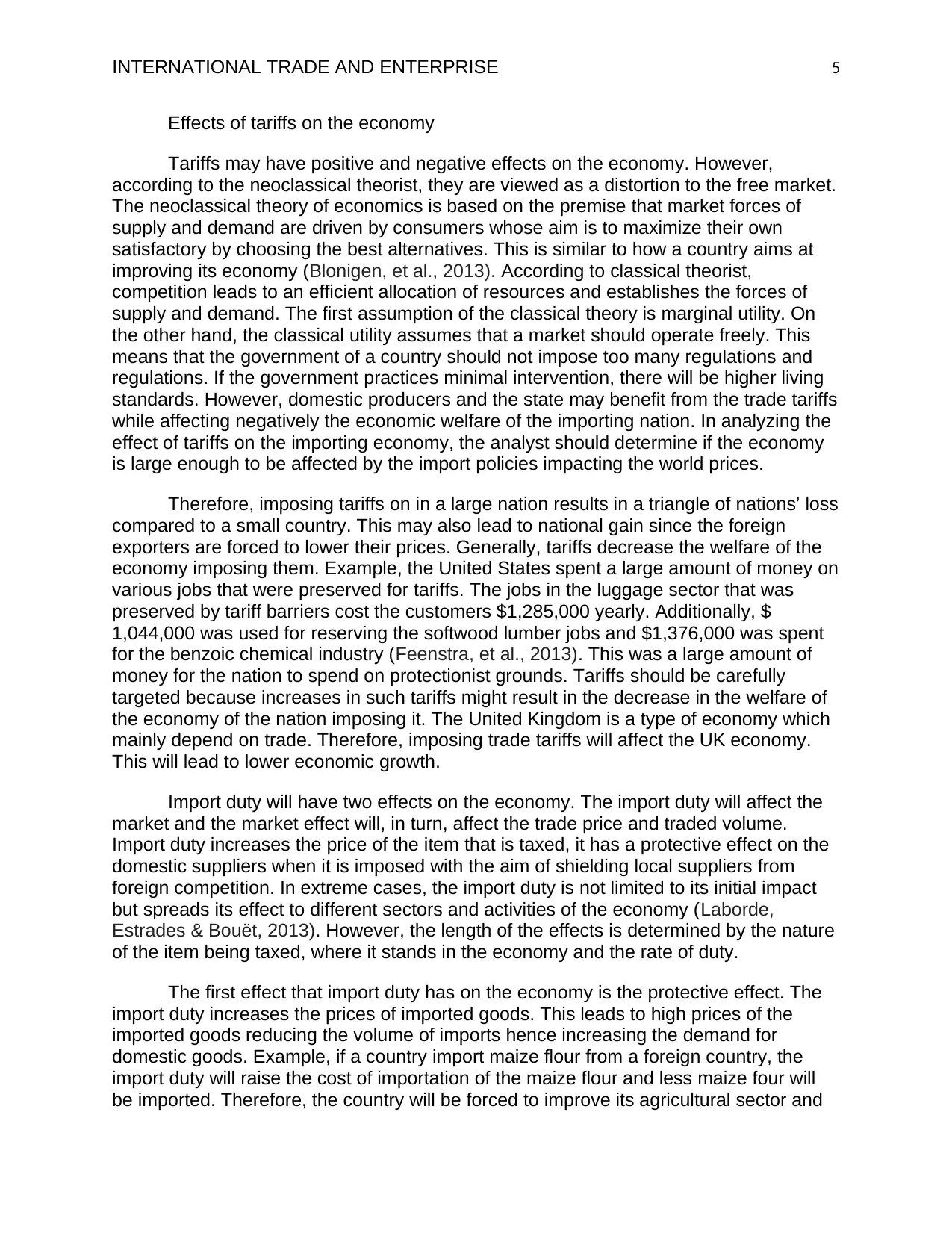
INTERNATIONAL TRADE AND ENTERPRISE 5
Effects of tariffs on the economy
Tariffs may have positive and negative effects on the economy. However,
according to the neoclassical theorist, they are viewed as a distortion to the free market.
The neoclassical theory of economics is based on the premise that market forces of
supply and demand are driven by consumers whose aim is to maximize their own
satisfactory by choosing the best alternatives. This is similar to how a country aims at
improving its economy (Blonigen, et al., 2013). According to classical theorist,
competition leads to an efficient allocation of resources and establishes the forces of
supply and demand. The first assumption of the classical theory is marginal utility. On
the other hand, the classical utility assumes that a market should operate freely. This
means that the government of a country should not impose too many regulations and
regulations. If the government practices minimal intervention, there will be higher living
standards. However, domestic producers and the state may benefit from the trade tariffs
while affecting negatively the economic welfare of the importing nation. In analyzing the
effect of tariffs on the importing economy, the analyst should determine if the economy
is large enough to be affected by the import policies impacting the world prices.
Therefore, imposing tariffs on in a large nation results in a triangle of nations’ loss
compared to a small country. This may also lead to national gain since the foreign
exporters are forced to lower their prices. Generally, tariffs decrease the welfare of the
economy imposing them. Example, the United States spent a large amount of money on
various jobs that were preserved for tariffs. The jobs in the luggage sector that was
preserved by tariff barriers cost the customers $1,285,000 yearly. Additionally, $
1,044,000 was used for reserving the softwood lumber jobs and $1,376,000 was spent
for the benzoic chemical industry (Feenstra, et al., 2013). This was a large amount of
money for the nation to spend on protectionist grounds. Tariffs should be carefully
targeted because increases in such tariffs might result in the decrease in the welfare of
the economy of the nation imposing it. The United Kingdom is a type of economy which
mainly depend on trade. Therefore, imposing trade tariffs will affect the UK economy.
This will lead to lower economic growth.
Import duty will have two effects on the economy. The import duty will affect the
market and the market effect will, in turn, affect the trade price and traded volume.
Import duty increases the price of the item that is taxed, it has a protective effect on the
domestic suppliers when it is imposed with the aim of shielding local suppliers from
foreign competition. In extreme cases, the import duty is not limited to its initial impact
but spreads its effect to different sectors and activities of the economy (Laborde,
Estrades & Bouët, 2013). However, the length of the effects is determined by the nature
of the item being taxed, where it stands in the economy and the rate of duty.
The first effect that import duty has on the economy is the protective effect. The
import duty increases the prices of imported goods. This leads to high prices of the
imported goods reducing the volume of imports hence increasing the demand for
domestic goods. Example, if a country import maize flour from a foreign country, the
import duty will raise the cost of importation of the maize flour and less maize four will
be imported. Therefore, the country will be forced to improve its agricultural sector and
Effects of tariffs on the economy
Tariffs may have positive and negative effects on the economy. However,
according to the neoclassical theorist, they are viewed as a distortion to the free market.
The neoclassical theory of economics is based on the premise that market forces of
supply and demand are driven by consumers whose aim is to maximize their own
satisfactory by choosing the best alternatives. This is similar to how a country aims at
improving its economy (Blonigen, et al., 2013). According to classical theorist,
competition leads to an efficient allocation of resources and establishes the forces of
supply and demand. The first assumption of the classical theory is marginal utility. On
the other hand, the classical utility assumes that a market should operate freely. This
means that the government of a country should not impose too many regulations and
regulations. If the government practices minimal intervention, there will be higher living
standards. However, domestic producers and the state may benefit from the trade tariffs
while affecting negatively the economic welfare of the importing nation. In analyzing the
effect of tariffs on the importing economy, the analyst should determine if the economy
is large enough to be affected by the import policies impacting the world prices.
Therefore, imposing tariffs on in a large nation results in a triangle of nations’ loss
compared to a small country. This may also lead to national gain since the foreign
exporters are forced to lower their prices. Generally, tariffs decrease the welfare of the
economy imposing them. Example, the United States spent a large amount of money on
various jobs that were preserved for tariffs. The jobs in the luggage sector that was
preserved by tariff barriers cost the customers $1,285,000 yearly. Additionally, $
1,044,000 was used for reserving the softwood lumber jobs and $1,376,000 was spent
for the benzoic chemical industry (Feenstra, et al., 2013). This was a large amount of
money for the nation to spend on protectionist grounds. Tariffs should be carefully
targeted because increases in such tariffs might result in the decrease in the welfare of
the economy of the nation imposing it. The United Kingdom is a type of economy which
mainly depend on trade. Therefore, imposing trade tariffs will affect the UK economy.
This will lead to lower economic growth.
Import duty will have two effects on the economy. The import duty will affect the
market and the market effect will, in turn, affect the trade price and traded volume.
Import duty increases the price of the item that is taxed, it has a protective effect on the
domestic suppliers when it is imposed with the aim of shielding local suppliers from
foreign competition. In extreme cases, the import duty is not limited to its initial impact
but spreads its effect to different sectors and activities of the economy (Laborde,
Estrades & Bouët, 2013). However, the length of the effects is determined by the nature
of the item being taxed, where it stands in the economy and the rate of duty.
The first effect that import duty has on the economy is the protective effect. The
import duty increases the prices of imported goods. This leads to high prices of the
imported goods reducing the volume of imports hence increasing the demand for
domestic goods. Example, if a country import maize flour from a foreign country, the
import duty will raise the cost of importation of the maize flour and less maize four will
be imported. Therefore, the country will be forced to improve its agricultural sector and
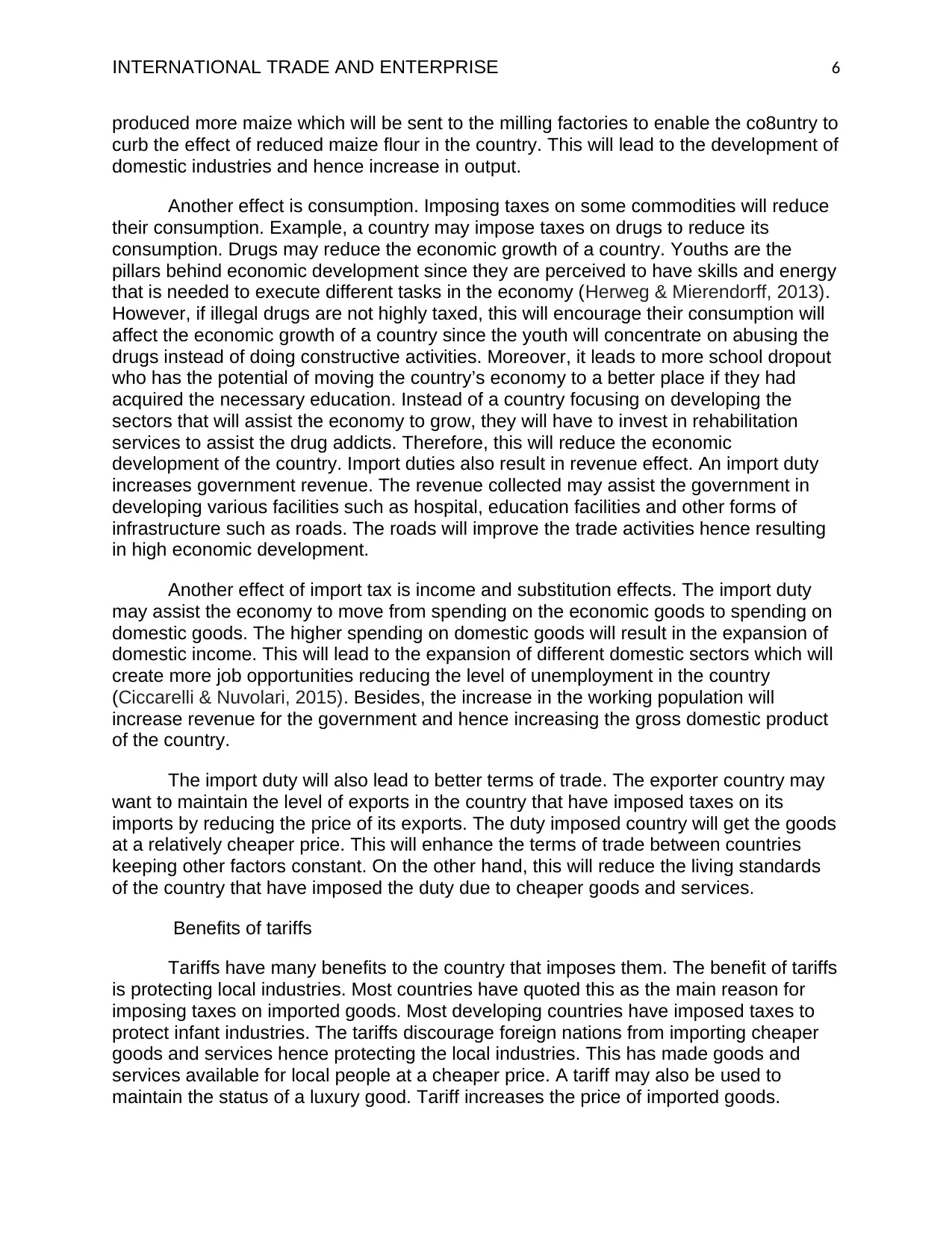
INTERNATIONAL TRADE AND ENTERPRISE 6
produced more maize which will be sent to the milling factories to enable the co8untry to
curb the effect of reduced maize flour in the country. This will lead to the development of
domestic industries and hence increase in output.
Another effect is consumption. Imposing taxes on some commodities will reduce
their consumption. Example, a country may impose taxes on drugs to reduce its
consumption. Drugs may reduce the economic growth of a country. Youths are the
pillars behind economic development since they are perceived to have skills and energy
that is needed to execute different tasks in the economy (Herweg & Mierendorff, 2013).
However, if illegal drugs are not highly taxed, this will encourage their consumption will
affect the economic growth of a country since the youth will concentrate on abusing the
drugs instead of doing constructive activities. Moreover, it leads to more school dropout
who has the potential of moving the country’s economy to a better place if they had
acquired the necessary education. Instead of a country focusing on developing the
sectors that will assist the economy to grow, they will have to invest in rehabilitation
services to assist the drug addicts. Therefore, this will reduce the economic
development of the country. Import duties also result in revenue effect. An import duty
increases government revenue. The revenue collected may assist the government in
developing various facilities such as hospital, education facilities and other forms of
infrastructure such as roads. The roads will improve the trade activities hence resulting
in high economic development.
Another effect of import tax is income and substitution effects. The import duty
may assist the economy to move from spending on the economic goods to spending on
domestic goods. The higher spending on domestic goods will result in the expansion of
domestic income. This will lead to the expansion of different domestic sectors which will
create more job opportunities reducing the level of unemployment in the country
(Ciccarelli & Nuvolari, 2015). Besides, the increase in the working population will
increase revenue for the government and hence increasing the gross domestic product
of the country.
The import duty will also lead to better terms of trade. The exporter country may
want to maintain the level of exports in the country that have imposed taxes on its
imports by reducing the price of its exports. The duty imposed country will get the goods
at a relatively cheaper price. This will enhance the terms of trade between countries
keeping other factors constant. On the other hand, this will reduce the living standards
of the country that have imposed the duty due to cheaper goods and services.
Benefits of tariffs
Tariffs have many benefits to the country that imposes them. The benefit of tariffs
is protecting local industries. Most countries have quoted this as the main reason for
imposing taxes on imported goods. Most developing countries have imposed taxes to
protect infant industries. The tariffs discourage foreign nations from importing cheaper
goods and services hence protecting the local industries. This has made goods and
services available for local people at a cheaper price. A tariff may also be used to
maintain the status of a luxury good. Tariff increases the price of imported goods.
produced more maize which will be sent to the milling factories to enable the co8untry to
curb the effect of reduced maize flour in the country. This will lead to the development of
domestic industries and hence increase in output.
Another effect is consumption. Imposing taxes on some commodities will reduce
their consumption. Example, a country may impose taxes on drugs to reduce its
consumption. Drugs may reduce the economic growth of a country. Youths are the
pillars behind economic development since they are perceived to have skills and energy
that is needed to execute different tasks in the economy (Herweg & Mierendorff, 2013).
However, if illegal drugs are not highly taxed, this will encourage their consumption will
affect the economic growth of a country since the youth will concentrate on abusing the
drugs instead of doing constructive activities. Moreover, it leads to more school dropout
who has the potential of moving the country’s economy to a better place if they had
acquired the necessary education. Instead of a country focusing on developing the
sectors that will assist the economy to grow, they will have to invest in rehabilitation
services to assist the drug addicts. Therefore, this will reduce the economic
development of the country. Import duties also result in revenue effect. An import duty
increases government revenue. The revenue collected may assist the government in
developing various facilities such as hospital, education facilities and other forms of
infrastructure such as roads. The roads will improve the trade activities hence resulting
in high economic development.
Another effect of import tax is income and substitution effects. The import duty
may assist the economy to move from spending on the economic goods to spending on
domestic goods. The higher spending on domestic goods will result in the expansion of
domestic income. This will lead to the expansion of different domestic sectors which will
create more job opportunities reducing the level of unemployment in the country
(Ciccarelli & Nuvolari, 2015). Besides, the increase in the working population will
increase revenue for the government and hence increasing the gross domestic product
of the country.
The import duty will also lead to better terms of trade. The exporter country may
want to maintain the level of exports in the country that have imposed taxes on its
imports by reducing the price of its exports. The duty imposed country will get the goods
at a relatively cheaper price. This will enhance the terms of trade between countries
keeping other factors constant. On the other hand, this will reduce the living standards
of the country that have imposed the duty due to cheaper goods and services.
Benefits of tariffs
Tariffs have many benefits to the country that imposes them. The benefit of tariffs
is protecting local industries. Most countries have quoted this as the main reason for
imposing taxes on imported goods. Most developing countries have imposed taxes to
protect infant industries. The tariffs discourage foreign nations from importing cheaper
goods and services hence protecting the local industries. This has made goods and
services available for local people at a cheaper price. A tariff may also be used to
maintain the status of a luxury good. Tariff increases the price of imported goods.
⊘ This is a preview!⊘
Do you want full access?
Subscribe today to unlock all pages.

Trusted by 1+ million students worldwide
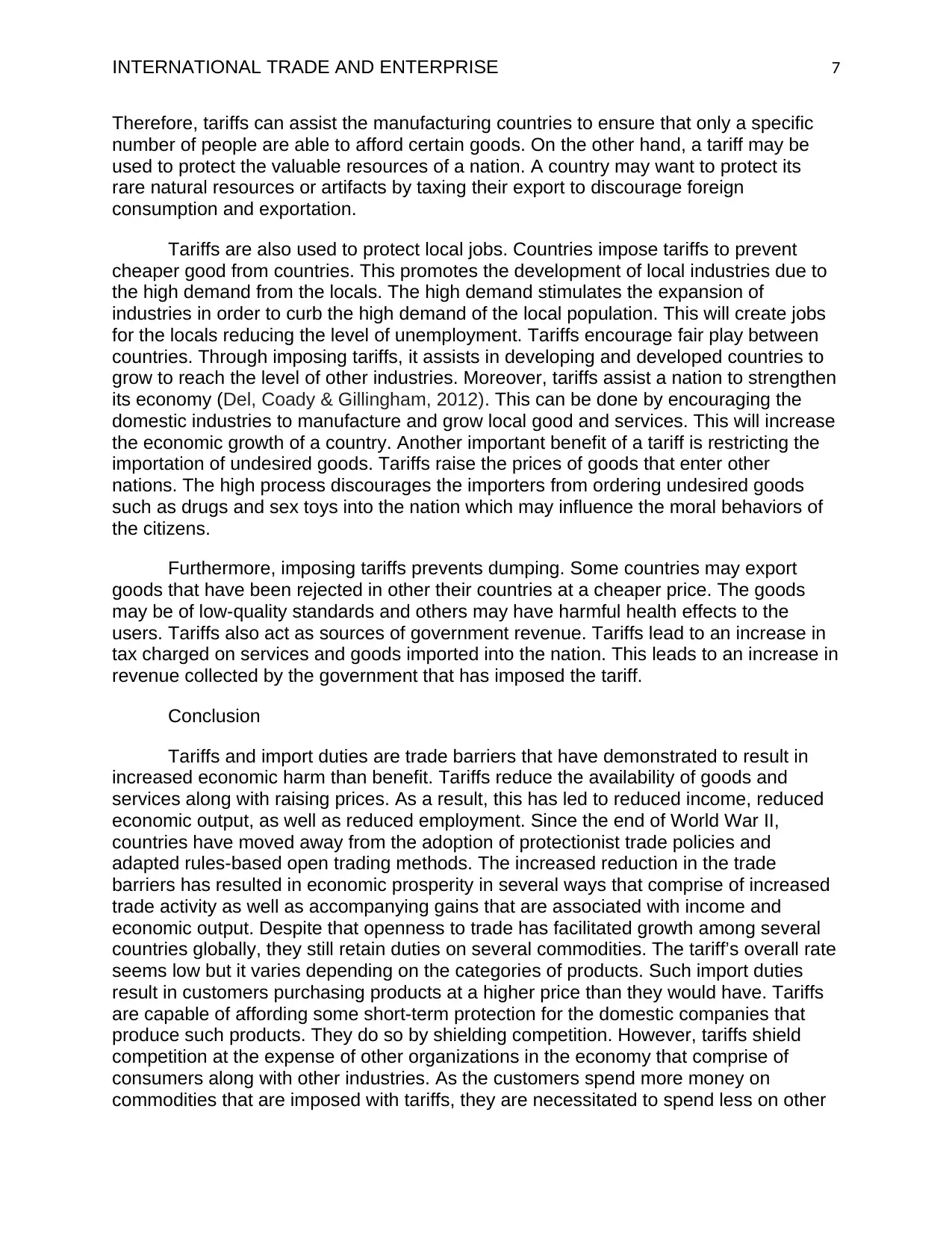
INTERNATIONAL TRADE AND ENTERPRISE 7
Therefore, tariffs can assist the manufacturing countries to ensure that only a specific
number of people are able to afford certain goods. On the other hand, a tariff may be
used to protect the valuable resources of a nation. A country may want to protect its
rare natural resources or artifacts by taxing their export to discourage foreign
consumption and exportation.
Tariffs are also used to protect local jobs. Countries impose tariffs to prevent
cheaper good from countries. This promotes the development of local industries due to
the high demand from the locals. The high demand stimulates the expansion of
industries in order to curb the high demand of the local population. This will create jobs
for the locals reducing the level of unemployment. Tariffs encourage fair play between
countries. Through imposing tariffs, it assists in developing and developed countries to
grow to reach the level of other industries. Moreover, tariffs assist a nation to strengthen
its economy (Del, Coady & Gillingham, 2012). This can be done by encouraging the
domestic industries to manufacture and grow local good and services. This will increase
the economic growth of a country. Another important benefit of a tariff is restricting the
importation of undesired goods. Tariffs raise the prices of goods that enter other
nations. The high process discourages the importers from ordering undesired goods
such as drugs and sex toys into the nation which may influence the moral behaviors of
the citizens.
Furthermore, imposing tariffs prevents dumping. Some countries may export
goods that have been rejected in other their countries at a cheaper price. The goods
may be of low-quality standards and others may have harmful health effects to the
users. Tariffs also act as sources of government revenue. Tariffs lead to an increase in
tax charged on services and goods imported into the nation. This leads to an increase in
revenue collected by the government that has imposed the tariff.
Conclusion
Tariffs and import duties are trade barriers that have demonstrated to result in
increased economic harm than benefit. Tariffs reduce the availability of goods and
services along with raising prices. As a result, this has led to reduced income, reduced
economic output, as well as reduced employment. Since the end of World War II,
countries have moved away from the adoption of protectionist trade policies and
adapted rules-based open trading methods. The increased reduction in the trade
barriers has resulted in economic prosperity in several ways that comprise of increased
trade activity as well as accompanying gains that are associated with income and
economic output. Despite that openness to trade has facilitated growth among several
countries globally, they still retain duties on several commodities. The tariff’s overall rate
seems low but it varies depending on the categories of products. Such import duties
result in customers purchasing products at a higher price than they would have. Tariffs
are capable of affording some short-term protection for the domestic companies that
produce such products. They do so by shielding competition. However, tariffs shield
competition at the expense of other organizations in the economy that comprise of
consumers along with other industries. As the customers spend more money on
commodities that are imposed with tariffs, they are necessitated to spend less on other
Therefore, tariffs can assist the manufacturing countries to ensure that only a specific
number of people are able to afford certain goods. On the other hand, a tariff may be
used to protect the valuable resources of a nation. A country may want to protect its
rare natural resources or artifacts by taxing their export to discourage foreign
consumption and exportation.
Tariffs are also used to protect local jobs. Countries impose tariffs to prevent
cheaper good from countries. This promotes the development of local industries due to
the high demand from the locals. The high demand stimulates the expansion of
industries in order to curb the high demand of the local population. This will create jobs
for the locals reducing the level of unemployment. Tariffs encourage fair play between
countries. Through imposing tariffs, it assists in developing and developed countries to
grow to reach the level of other industries. Moreover, tariffs assist a nation to strengthen
its economy (Del, Coady & Gillingham, 2012). This can be done by encouraging the
domestic industries to manufacture and grow local good and services. This will increase
the economic growth of a country. Another important benefit of a tariff is restricting the
importation of undesired goods. Tariffs raise the prices of goods that enter other
nations. The high process discourages the importers from ordering undesired goods
such as drugs and sex toys into the nation which may influence the moral behaviors of
the citizens.
Furthermore, imposing tariffs prevents dumping. Some countries may export
goods that have been rejected in other their countries at a cheaper price. The goods
may be of low-quality standards and others may have harmful health effects to the
users. Tariffs also act as sources of government revenue. Tariffs lead to an increase in
tax charged on services and goods imported into the nation. This leads to an increase in
revenue collected by the government that has imposed the tariff.
Conclusion
Tariffs and import duties are trade barriers that have demonstrated to result in
increased economic harm than benefit. Tariffs reduce the availability of goods and
services along with raising prices. As a result, this has led to reduced income, reduced
economic output, as well as reduced employment. Since the end of World War II,
countries have moved away from the adoption of protectionist trade policies and
adapted rules-based open trading methods. The increased reduction in the trade
barriers has resulted in economic prosperity in several ways that comprise of increased
trade activity as well as accompanying gains that are associated with income and
economic output. Despite that openness to trade has facilitated growth among several
countries globally, they still retain duties on several commodities. The tariff’s overall rate
seems low but it varies depending on the categories of products. Such import duties
result in customers purchasing products at a higher price than they would have. Tariffs
are capable of affording some short-term protection for the domestic companies that
produce such products. They do so by shielding competition. However, tariffs shield
competition at the expense of other organizations in the economy that comprise of
consumers along with other industries. As the customers spend more money on
commodities that are imposed with tariffs, they are necessitated to spend less on other
Paraphrase This Document
Need a fresh take? Get an instant paraphrase of this document with our AI Paraphraser
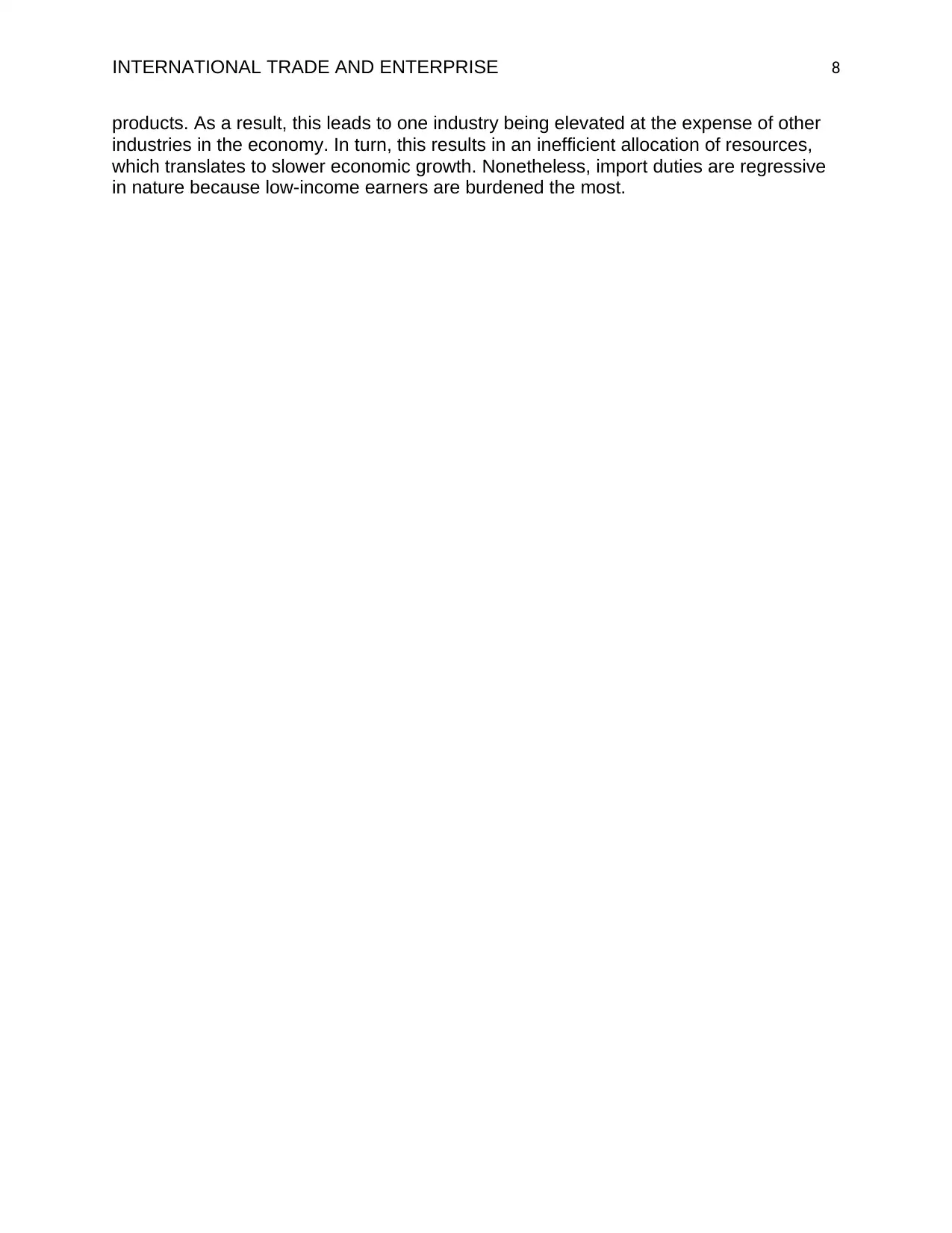
INTERNATIONAL TRADE AND ENTERPRISE 8
products. As a result, this leads to one industry being elevated at the expense of other
industries in the economy. In turn, this results in an inefficient allocation of resources,
which translates to slower economic growth. Nonetheless, import duties are regressive
in nature because low-income earners are burdened the most.
products. As a result, this leads to one industry being elevated at the expense of other
industries in the economy. In turn, this results in an inefficient allocation of resources,
which translates to slower economic growth. Nonetheless, import duties are regressive
in nature because low-income earners are burdened the most.
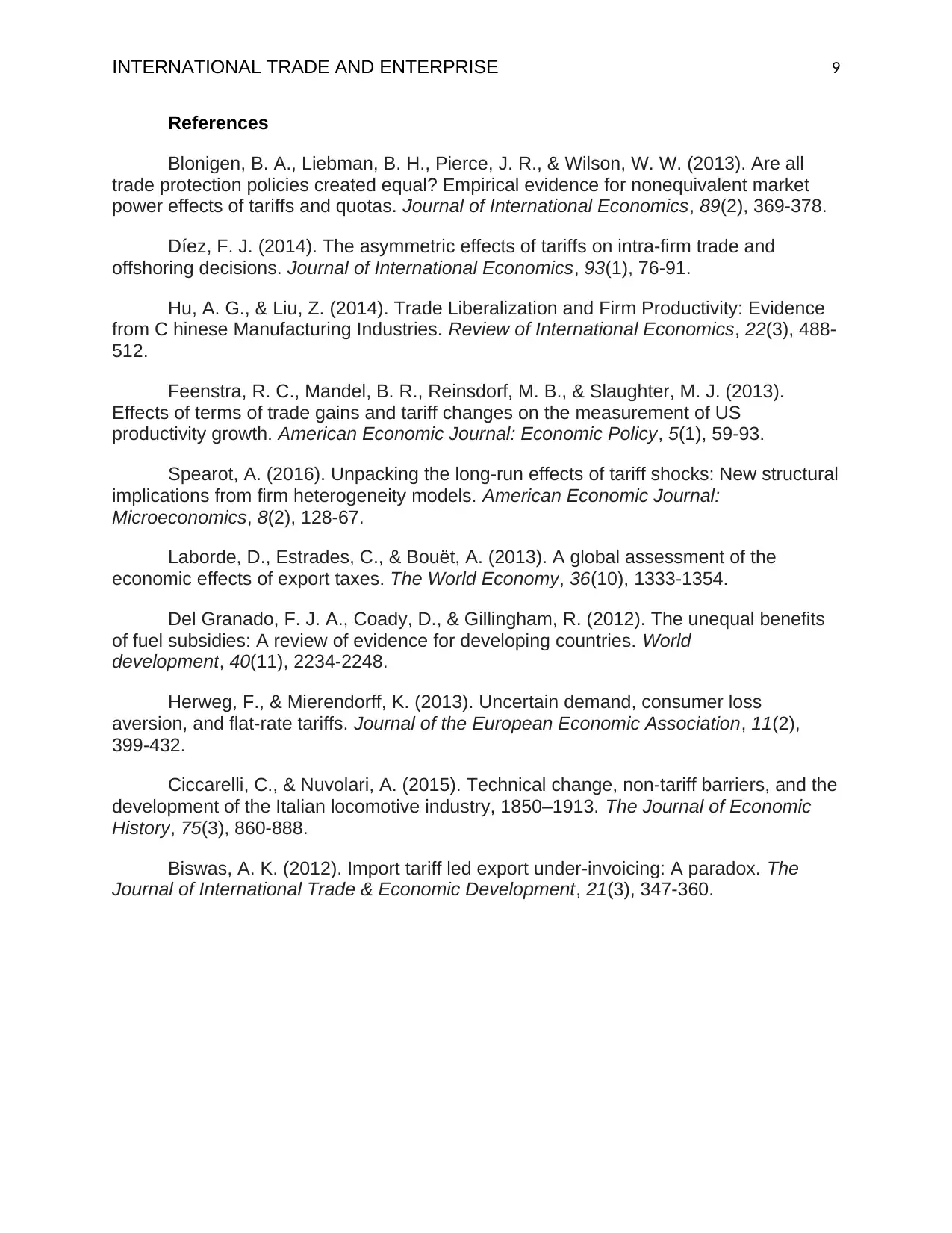
INTERNATIONAL TRADE AND ENTERPRISE 9
References
Blonigen, B. A., Liebman, B. H., Pierce, J. R., & Wilson, W. W. (2013). Are all
trade protection policies created equal? Empirical evidence for nonequivalent market
power effects of tariffs and quotas. Journal of International Economics, 89(2), 369-378.
Díez, F. J. (2014). The asymmetric effects of tariffs on intra-firm trade and
offshoring decisions. Journal of International Economics, 93(1), 76-91.
Hu, A. G., & Liu, Z. (2014). Trade Liberalization and Firm Productivity: Evidence
from C hinese Manufacturing Industries. Review of International Economics, 22(3), 488-
512.
Feenstra, R. C., Mandel, B. R., Reinsdorf, M. B., & Slaughter, M. J. (2013).
Effects of terms of trade gains and tariff changes on the measurement of US
productivity growth. American Economic Journal: Economic Policy, 5(1), 59-93.
Spearot, A. (2016). Unpacking the long-run effects of tariff shocks: New structural
implications from firm heterogeneity models. American Economic Journal:
Microeconomics, 8(2), 128-67.
Laborde, D., Estrades, C., & Bouët, A. (2013). A global assessment of the
economic effects of export taxes. The World Economy, 36(10), 1333-1354.
Del Granado, F. J. A., Coady, D., & Gillingham, R. (2012). The unequal benefits
of fuel subsidies: A review of evidence for developing countries. World
development, 40(11), 2234-2248.
Herweg, F., & Mierendorff, K. (2013). Uncertain demand, consumer loss
aversion, and flat-rate tariffs. Journal of the European Economic Association, 11(2),
399-432.
Ciccarelli, C., & Nuvolari, A. (2015). Technical change, non-tariff barriers, and the
development of the Italian locomotive industry, 1850–1913. The Journal of Economic
History, 75(3), 860-888.
Biswas, A. K. (2012). Import tariff led export under-invoicing: A paradox. The
Journal of International Trade & Economic Development, 21(3), 347-360.
References
Blonigen, B. A., Liebman, B. H., Pierce, J. R., & Wilson, W. W. (2013). Are all
trade protection policies created equal? Empirical evidence for nonequivalent market
power effects of tariffs and quotas. Journal of International Economics, 89(2), 369-378.
Díez, F. J. (2014). The asymmetric effects of tariffs on intra-firm trade and
offshoring decisions. Journal of International Economics, 93(1), 76-91.
Hu, A. G., & Liu, Z. (2014). Trade Liberalization and Firm Productivity: Evidence
from C hinese Manufacturing Industries. Review of International Economics, 22(3), 488-
512.
Feenstra, R. C., Mandel, B. R., Reinsdorf, M. B., & Slaughter, M. J. (2013).
Effects of terms of trade gains and tariff changes on the measurement of US
productivity growth. American Economic Journal: Economic Policy, 5(1), 59-93.
Spearot, A. (2016). Unpacking the long-run effects of tariff shocks: New structural
implications from firm heterogeneity models. American Economic Journal:
Microeconomics, 8(2), 128-67.
Laborde, D., Estrades, C., & Bouët, A. (2013). A global assessment of the
economic effects of export taxes. The World Economy, 36(10), 1333-1354.
Del Granado, F. J. A., Coady, D., & Gillingham, R. (2012). The unequal benefits
of fuel subsidies: A review of evidence for developing countries. World
development, 40(11), 2234-2248.
Herweg, F., & Mierendorff, K. (2013). Uncertain demand, consumer loss
aversion, and flat-rate tariffs. Journal of the European Economic Association, 11(2),
399-432.
Ciccarelli, C., & Nuvolari, A. (2015). Technical change, non-tariff barriers, and the
development of the Italian locomotive industry, 1850–1913. The Journal of Economic
History, 75(3), 860-888.
Biswas, A. K. (2012). Import tariff led export under-invoicing: A paradox. The
Journal of International Trade & Economic Development, 21(3), 347-360.
⊘ This is a preview!⊘
Do you want full access?
Subscribe today to unlock all pages.

Trusted by 1+ million students worldwide
1 out of 9
Related Documents
Your All-in-One AI-Powered Toolkit for Academic Success.
+13062052269
info@desklib.com
Available 24*7 on WhatsApp / Email
![[object Object]](/_next/static/media/star-bottom.7253800d.svg)
Unlock your academic potential
Copyright © 2020–2025 A2Z Services. All Rights Reserved. Developed and managed by ZUCOL.





